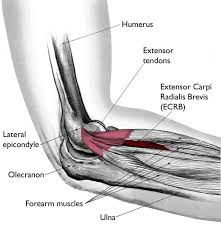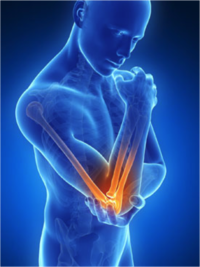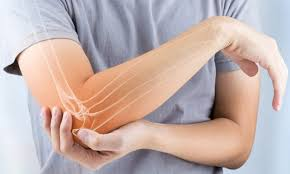 This is an extremely common overuse condition that causes pain on the outside of the elbow. Overuse of the muscles of the forearm, wrist and elbow can put too much strain on the elbow extensor tendons. Overtime, this can cause disrupted healing patterns in the tendon structure that can lead to pain on the outside or “lateral” elbow.
This is an extremely common overuse condition that causes pain on the outside of the elbow. Overuse of the muscles of the forearm, wrist and elbow can put too much strain on the elbow extensor tendons. Overtime, this can cause disrupted healing patterns in the tendon structure that can lead to pain on the outside or “lateral” elbow.
Despite its name this condition is rarely related to playing tennis! It often occurs with repetitive forearm/wrist and elbow activities such as computer use, heavy lifting, repetitive twisting, or vibration. People with occupations that require repetitive hand and wrist movements (carpenters, electricians, desk bound jobs, equipment operators) often suffer from this condition. It can also occur in baseball, squash, and badminton players!
 With tennis elbow the pain is usually located on the outside of the elbow; however, may radiate upwards along the upper arm or down along the outside of the forearm. It is often aggravated with wrist/elbow movements, gripping, or twisting. People with this condition often report weakness with grip strength, and difficulty carrying objects in their hand, especially with the elbow extended (carrying shopping bags for example!)
With tennis elbow the pain is usually located on the outside of the elbow; however, may radiate upwards along the upper arm or down along the outside of the forearm. It is often aggravated with wrist/elbow movements, gripping, or twisting. People with this condition often report weakness with grip strength, and difficulty carrying objects in their hand, especially with the elbow extended (carrying shopping bags for example!)
This condition is most common in those between 30-50 years of age and affects males and females equally. This condition most commonly affects the dominant arm, as we are more likely to overuse it!
 Physiotherapy treatment for tennis elbow often involves manual therapy to release or stretch tight muscles in the forearm, as well as exercises to strengthen the affected muscles and tendons in a way that promotes healing (eccentric loading). Physiotherapy treatment may also involve taping or braces to offload or protect the affected tendons, as well as dry needling or acupuncture, and activity modification. Physiotherapy can also address some of the risk factors for tennis elbow, such as strength or flexibility deficits in the neck, shoulder, elbow and wrist, training errors or poor form and muscle imbalances.
Physiotherapy treatment for tennis elbow often involves manual therapy to release or stretch tight muscles in the forearm, as well as exercises to strengthen the affected muscles and tendons in a way that promotes healing (eccentric loading). Physiotherapy treatment may also involve taping or braces to offload or protect the affected tendons, as well as dry needling or acupuncture, and activity modification. Physiotherapy can also address some of the risk factors for tennis elbow, such as strength or flexibility deficits in the neck, shoulder, elbow and wrist, training errors or poor form and muscle imbalances.
